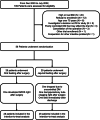Comparison of Clinical Outcomes and Postoperative Nutritional Status Between Early and Late Oral Feeding After Esophagectomy: An Open Labeled Randomized Controlled Trial
- PMID: 38994579
- PMCID: PMC11809704
- DOI: 10.1097/SLA.0000000000006441
Comparison of Clinical Outcomes and Postoperative Nutritional Status Between Early and Late Oral Feeding After Esophagectomy: An Open Labeled Randomized Controlled Trial
Abstract
Objective: To compare nutritional and postoperative outcomes between early oral feeding and late oral feeding with jejunostomy feeding support after esophagectomy.
Background: Esophagectomy is associated with substantial body weight loss and malnutrition, impacting the prognosis of esophageal cancer patients. Despite many studies on postesophagectomy nutritional support, optimal strategies remain elusive. This study investigates the impact of jejunostomy feeding with late oral feeding compared to conventional oral feeding on nutritional and postoperative outcomes.
Methods: We performed a single-center prospective open-labelled randomized controlled trial between 2020 and 2022. Patients aged 18 to 75 years with resectable esophageal cancer were randomly assigned to undergo either early oral feeding (early group) or late oral feeding with jejunostomy feeding support (late group) after esophagectomy. The primary endpoint was body weight loss from preoperative body weight at postoperative 4 to 5 weeks and 4 months. Other perioperative and nutritional outcomes were also evaluated.
Results: We randomly assigned 29 patients to the early group and 29 patients to the late group. The late group exhibited significantly less body weight loss at both postoperative 4 to 5 weeks (8.3% vs. 5.6%; P =0.002) and 4 months (15.0% vs. 10.5%; P =0.003). The total calorie intake and protein intake were higher in the late group for both postoperative 4 to 5 weeks (1800 kcal/day vs. 1100 kcal/day; P <0.001) and 4 months (1565 kcal/day vs. 1200 kcal/day; P =0.010). Sixty percentage of the early group changed to malnutrition state, while 40% of the late group changed to malnutrition. The complication rate and length of hospital stays were similar.
Conclusions: The late group demonstrated prevention of significant body weight loss, enhanced nutritional intake, and reduced malnutrition without compromising short-term surgical outcomes.
Copyright © 2024 The Author(s). Published by Wolters Kluwer Health, Inc.
Conflict of interest statement
The authors declare no conflicts of interest.
Figures
References
-
- Uhlenhopp DJ, Then EO, Sunkara T, et al. . Epidemiology of esophageal cancer: Update in global trends, etiology and risk factors. Clin J Gastroenterol. 2020;13:1010–1021. - PubMed
-
- Na KJ, Kang CH, Park S, et al. . Robotic esophagectomy versus open esophagectomy in esophageal squamous cell carcinoma: A propensity-score matched analysis. J Robot Surg. 2021:1–8. - PubMed
-
- Gupta R, Ihmaidat H. Nutritional effects of oesophageal, gastric and pancreatic carcinoma. Eur J Surgl Oncol (EJSO). 2003;29:634–643. - PubMed
Publication types
MeSH terms
LinkOut - more resources
Full Text Sources
Medical


